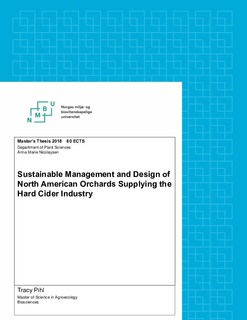| dc.contributor.advisor | Nicolaysen, Anna Marie | |
| dc.contributor.advisor | Francis, Charles | |
| dc.contributor.author | Pihl, Tracy | |
| dc.coverage.spatial | North America, Pacific Coast | nb_NO |
| dc.date.accessioned | 2018-10-25T10:56:05Z | |
| dc.date.available | 2018-10-25T10:56:05Z | |
| dc.date.issued | 2018 | |
| dc.identifier.uri | http://hdl.handle.net/11250/2569544 | |
| dc.description.abstract | The hard cider industry is quickly growing in North America. In this research I investigate how apple production in North America has adapted to meet the demands of the rapidly growing hard cider industry, and whether this expansion and adaptation is sustainable. Specifically I seek to understand how orchard managers are shifting production or expanding their orchard to supply the cider market, what techniques and management practices are currently in use, and how this is impacting the agroecosystem, the surrounding ecosystem, and the landscape ecology of the region.
I chose to examine the sustainability of orchards supplying the hard cider industry through a series of five case studies conducted along the North American west coast. I applied an adapted framework of ‘A Rapid, Farmer-Friendly Agroecological Method to Estimate Soil Quality and Crop Health in Vineyard Systems’ consisting of surveys and analysis by the Altieri Agroecology Research Group at UC Berkeley, and conducted supplemental interviews. The surveys are designed to measure the sustainability of the five orchard agroecosystems through a participatory, comparative, quantitative analysis of synergies occurring within the system. Semi-structured interviews complement the surveys to provide a mixed-methods analysis. My research also draws on applied island biogeography theory to analyze biodiversity and habitat fragmentation at the landscape scale.
The five orchards which participated in this research are all above the sustainability threshold used. My findings suggest that the cider industry is proving to be a high value market opportunity for small scale, sustainably run orchards which could not compete economically with larger operations to provide culinary apples. This research also suggests that the cider industry has potential to effectively utilize a wide variety of agroforestry techniques. I would also put forward that cider orchards could successfully be operated as low input systems under the right conditions and still be economically viable. I conclude with a discussion on the cider industry’s potential to compete with the wine industry in northern California and decrease habitat fragmentation for native pollinators in the region by increasing landscape diversity. | nb_NO |
| dc.language.iso | eng | nb_NO |
| dc.publisher | Norwegian University of Life Sciences, Ås | nb_NO |
| dc.rights | Attribution-NonCommercial-NoDerivatives 4.0 Internasjonal | * |
| dc.rights.uri | http://creativecommons.org/licenses/by-nc-nd/4.0/deed.no | * |
| dc.subject | Sustainability | nb_NO |
| dc.subject | Agroecology | nb_NO |
| dc.subject | Biodiversity | nb_NO |
| dc.title | Sustainable management and design of North American orchards supplying the hard cider industry | nb_NO |
| dc.type | Master thesis | nb_NO |
| dc.subject.nsi | VDP::Landbruks- og Fiskerifag: 900::Landbruksfag: 910::Planteforedling, hagebruk, plantevern, plantepatologi: 911 | nb_NO |
| dc.description.localcode | M-AE | nb_NO |

